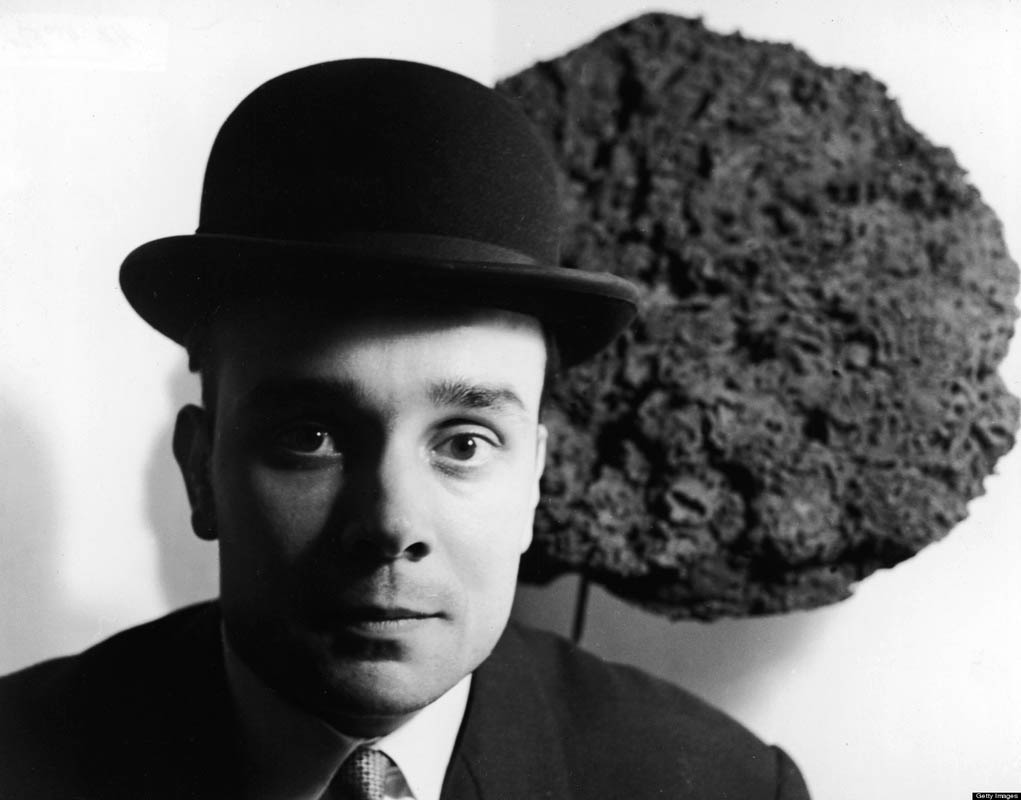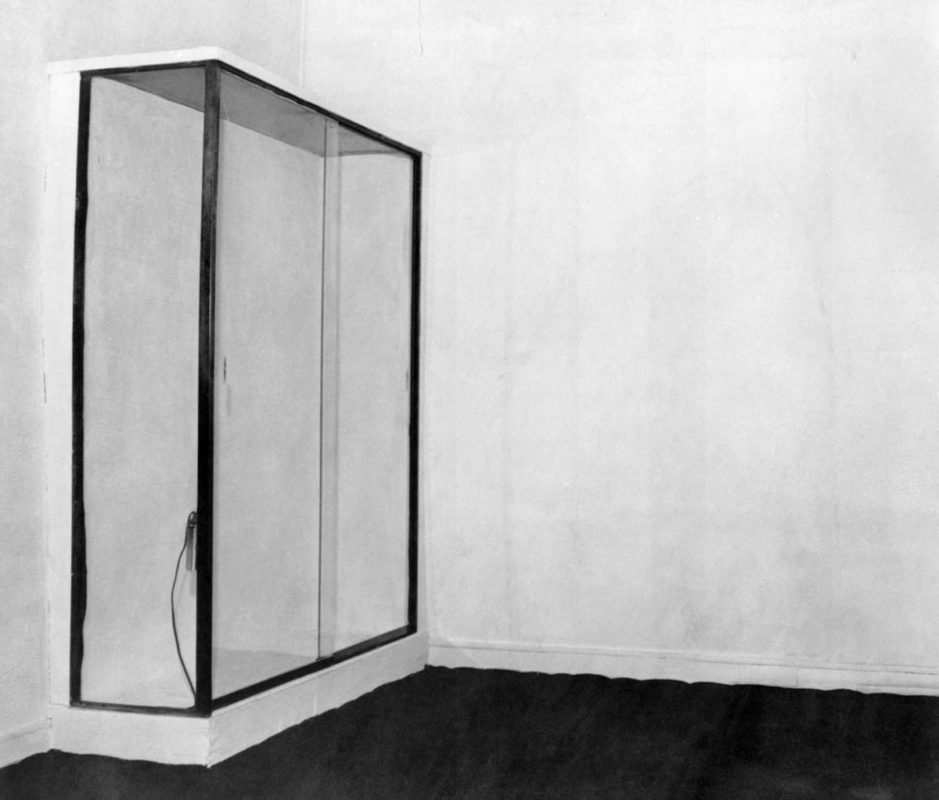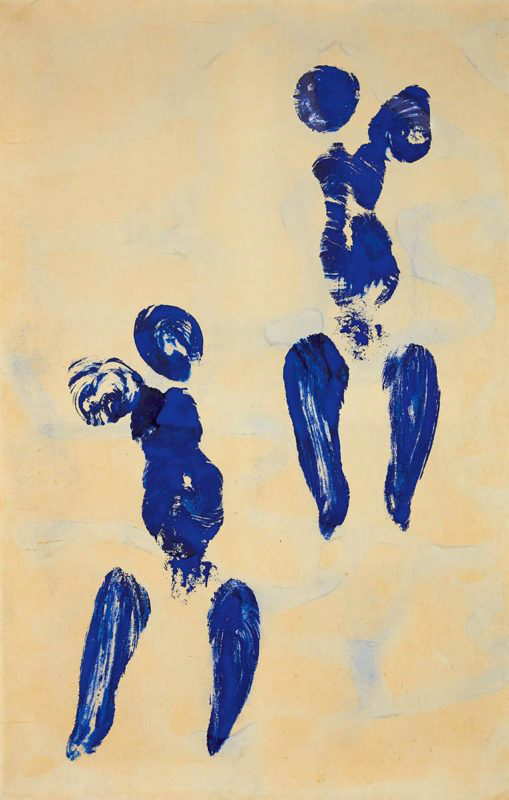Guy Who Does Art Realting to Blue and the Body

Yves Klein is a French creative person, a member of the Nouveau réalisme group, and an inventor of the International Klein Blueish color. This shade of blueish is used in many of his famous blue paintings. During his brusk life, Klein made a nifty impact on modern fine art history. He created proto-conceptual artworks, proto-performances, and explored ideas of spirituality immateriality in art. Here, we explore the fascinating life and work of the great Yves Klein.
ane. Yves Klein Was A Very Spiritual Artist

Yves Klein was inspired by many things and found spirituality in his judo practice, Christianity, and mysticism. He was born into a family unit of artists in 1928. His mother, Marie Raymond, was a well-known abstruse painter, and his father, Fred Klein, created figurative paintings.
Despite his artistic roots, Klein wanted to be a judoist at commencement. In 1947, he started preparation judo. Five years late he even traveled to Japan for training and received a 4th dan blackbelt. At the time, he was the only French person to have one. Klein fifty-fifty wrote a book on the foundations of Judo and wanted to become a judo instructor, so he opened his judo school in 1955. Information technology's worth noting that the school was designed in monochrome colors we see in Klein'south artworks.

Yves Klein also learned nigh the mysticism of the Rosicrucian order and read works written by the philosopher Gaston Bachelard. When he was nineteen years old he read Cosmogonie by Max Heindel – a volume that was considered of import for the Rosicrucian Club. Klein was so drawn to their philosophy and ideas that he started getting lessons by mail from the Rosicrucian Club in California. The creative person also knew a lot virtually Buddhism and Buddhist teachings.
Are yous enjoying this commodity?
Sign up to our Gratis Weekly Newsletter
Please bank check your inbox to actuate your subscription
Give thanks yous!

Yves Klein'due south spirituality tin can as well be seen through the artist'southward dedication to Saint Rita of Cascia, the patron saint of lost causes. To requite thanks to Saint Rita, Klein donated a beautiful artwork know as his Ex-voto to the monastery of Saint Rita of Cascia in Italy in 1961. In this small, but exquisite piece of work we can see all of the typical Yves Klein visual elements. His monochrome colors are nowadays, including the International Klein Blueish seen in his blue paintings. The work was, however, discovered much later, in 1979. During his life, Klein made at least 5 pilgrimages to Cascia and even wrote a handwritten prayer to Saint Rita. It's as well interesting to note that the edifice in Paris, where Klein made his piece Leap into the Void, later became a church dedicated to Saint Rita.
2. Klein Was A Member Of Nouveau Réalisme Movemement

Constitutive Declaration of New Realism, 1960, via Yves Klein's Website
During his exhibition called Yves, paintings in Paris, Klein met the art critic Pierre Restany. Restany was a key figure for the development of the Nouveau réalisme movement. This French art movement was founded in October of 1960. The Nouveau réalisme Manifesto was written on a piece of newspaper that was colored in the famous International Klein Blue seen in Klein'southward bluish paintings. The Manifesto was signed past the creative person himself, Restany, and six other people. Artists who signed the certificate were Arman, Daniel Spoerri, Jean Tinguely, Raymond Hains, Francois Dufrene, and Jacques de la Villegle. In later years, artists like Mimmo Rotella, Christo, and Niki de Saint Phalle also joined the move.
The term Nouveau réalisme was created by Restany. He was referring to the 19th-century fine art movement Realism, with the added prefix New. Similar New Realism, other New movements were Nouvelle Vague, also known as the New Wave, and Neo-Dada. The move is thought of as the French equivalent to American Popular art.

The artists of New Realism used many techniques and created a variety of artworks. They made collages, assemblages, wrappings, sculptures, proto-performances, and much more. The New Realists organized group exhibitions in 1962 and 1963, only the movement remained active for around 10 years.
During his career, Yves Klein collaborated with another Nouveau réalisme creative person Jean Tinguely. Together they made three kinetic sculptures. He also created relief portraits of fellow New Realism artists similar Arman and Martial Raysse based on life-sized plaster models of their figures. And you guessed it, they were also colored blueish.
three. Klein Made Conceptual Fine art Before The Movement Was Born

Yves Klein experimented with a type of immaterial art that was soon to get known as conceptual fine art. And then, information technology's rubber to say that he had a major influence on conceptual art.
In his 1960 piece Leap into the Void Yves Klein presented his attempt to fly. In this
black and white photo, we run into a nicely dressed Klein falling from the heaven and almost hitting the pavement of a Parisian street in the Fontenay-aux-Roses. The photographs serve as documentation of this operation of Klein's. Artists Jean Kender and Harry Shunk took the photos of the leap. The concluding photo is, however, a montage, or should we say – information technology is "photoshopped." For the creation of the work, several people helped Klein by holding a trampoline where the artist could autumn without getting hurt.

Another proto-conceptual work of Klein'south is called The Void. Klein had pronounced his paintings invisible in 1958, and for the exhibition of The Void at the Iris Clert Gallery in Paris, he wanted to take the idea of immateriality even further. He exhibited the empty infinite of the gallery. There was nothing to be seen inside and the mere exhibition was the artwork itself. It's interesting to know that during the opening blue drinks were being served to guests, and those bluish cocktails supposedly turned guests' urine blue.
For the opening of the exhibition, Klein likewise released 1000 blueish balloons to the sky. He even sold two immaterial paintings at the Iris Clert Gallery. If nosotros attempt to understand the opening of the exhibition, the flying balloons, the blue cocktails, and the people who came to the gallery every bit the artwork, then we get shut to ideas related to conceptual art, happenings, and operation fine art. Those fine art movements were of grade all the same to come, so it safe to say that Yves Klein was ahead of his time.

Nosotros can surely say that Klein was fascinated with the idea of immateriality. Another fascinating work made by Klein was named the Zone of Immaterial Pictorial Sensibility. The piece of work itself was immaterial and therefore, invisible. The people who chose to buy it received a cheque stating the ownership of the work. For this piece, however, Klein didn't accept money. Payment could only be made in gold. Right afterward receiving the gold, Klein threw a part of it into the Seine or the sea. People who bought the work were asked to burn the cheques they had priorly received. Finally, the buyers concluded up with nil, so the immaterial slice Klein had in mind was achieved. The Zone of Immaterial Pictorial Sensibility is a fine example of a proto-conceptual artwork.
iv. Klein Is Famous For His Bluish Paintings

For Klein, color was the fashion to arrive bear upon with the immaterial and infinite. He began painting his monochromes in 1947. Klein even claimed that in the future artists would simply utilize 1 color in their works. Klein'due south most famous works are probably his blue paintings, but in the monochrome paintings, the artist also used colors pink, gold, and orange. During his artistic career, Yves Klein painted around two hundred blueish paintings.
Klein'southward blue was supposed to represent the immaterial, the pure grade, and infinite. Bluish was infinite like the sky. Klein even trademarked the color in 1957 and named information technology International Klein Blue or IKB. Bluish had no dimensions. Klein was too inspired past the blue skies of Giotto's paintings in the Basilica of San Francesco in Assisi, which he visited.
In 1956, Yves Klein organized an exhibition called Monochromes at the Colette Allendy Gallery in Paris. Here, the artist exhibited only his monochrome works, including his blue paintings.

In 1957, he presented eleven of his blue paintings at the Gallery Apollinaire in Milan, Italy. The blueish paintings were exhibited 20 cm away from the wall and then that it seemed like they were levitating in infinite. The canvases only showed a saturated blue color, so the viewers could become lost in the colored infinite of blue paintings.
Klein likewise painted many sculptures in his famous shade we see in the blue paintings. He painted sponges and reliefs. He even recreated several ancient sculptures and painted them blue. At that place is his beautiful version of Victory of Samothrace and his Venus Bleue modeled later on Venus de Milo. The artist too made a bluish version of Michelangelo'southward Dying Slave sculpture.
5. Yves Klein Used Human Bodies As Paintbrushes

For the creation of his Anthropometry series in 1960, Klein directed nude women to roll their bodies in blue paint and then leave marks on canvases. Therefore, female bodies functioned as paintbrushes in this series. The shade of blue paint was the same one used in Klein'due south blue paintings. For the Anthropometry series, Klein was supposedly inspired past the way bodies left marks on mats in Judo.
Klein besides organized events for the creation of the Anthropometry paintings. Guests were invited to sentry models paint the canvases blue with their bodies while drinking blue cocktails and listening to music. Klein'due south musical choice was also unusual. The Monotone-Silence Symphony which was played during the painting session consisted of only one note existence repeatedly played for twenty minutes, followed by twenty minutes of silence.
Human bodies were non the only interesting "tool" Klein used in the procedure of creating art. The creative person as well created fascinating works and abstract shapes with fire. He created a series of his Fire Paintings in 1961 for which he used a blow torch weighing almost fourscore pounds. These works were made with the help of the laboratory of the National Gasworks of France. A firefighter was ever by Klein's side so that no accidents would happen.
Source: https://www.thecollector.com/yves-klein-blue-paintings/
0 Response to "Guy Who Does Art Realting to Blue and the Body"
Post a Comment